Hand Hygiene Compliance in Healthcare Facilities: A Critical Report
VerifiedAdded on 2020/05/04
|15
|3962
|69
Report
AI Summary
This report presents a critical evaluation of ten articles focused on hand hygiene compliance within healthcare settings, particularly in intensive care facilities. The articles explore various methodologies and technologies, including RFID-based monitoring systems, finite state machines, and augmented reality, to enhance hand hygiene practices. The report summarizes the findings of each article, highlighting their strengths, limitations, and contributions to the field. Key themes include the importance of education, training, and the use of alcohol-based handrubs for improved compliance. The report also addresses the challenges of non-compliance, identifying contributing factors and proposing interventions to improve hand hygiene practices. The research emphasizes the crucial role of hand hygiene in preventing healthcare-associated infections and ensuring patient safety. The report concludes that proper education and training are essential for effective hand hygiene compliance in healthcare facilities.
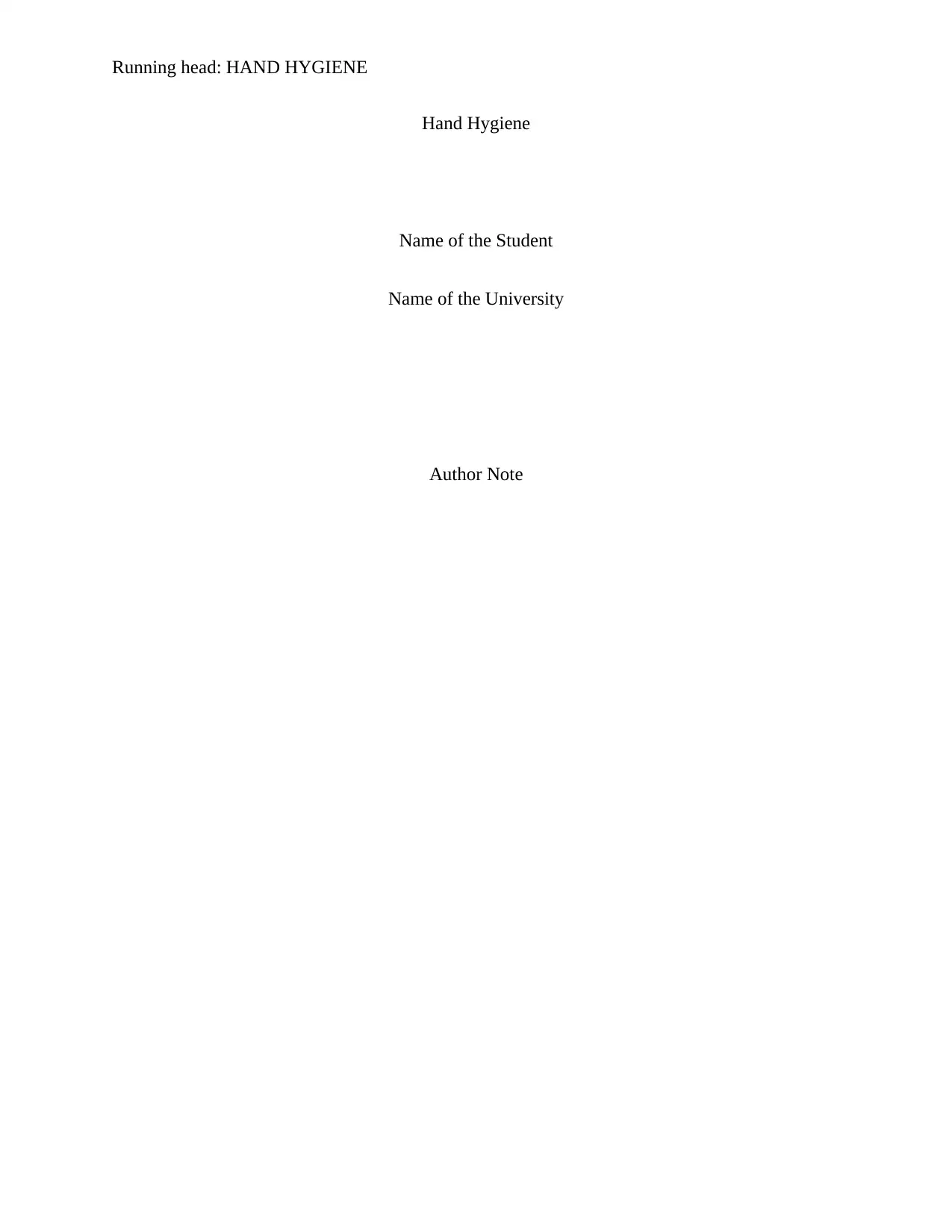
Running head: HAND HYGIENE
Hand Hygiene
Name of the Student
Name of the University
Author Note
Hand Hygiene
Name of the Student
Name of the University
Author Note
Paraphrase This Document
Need a fresh take? Get an instant paraphrase of this document with our AI Paraphraser
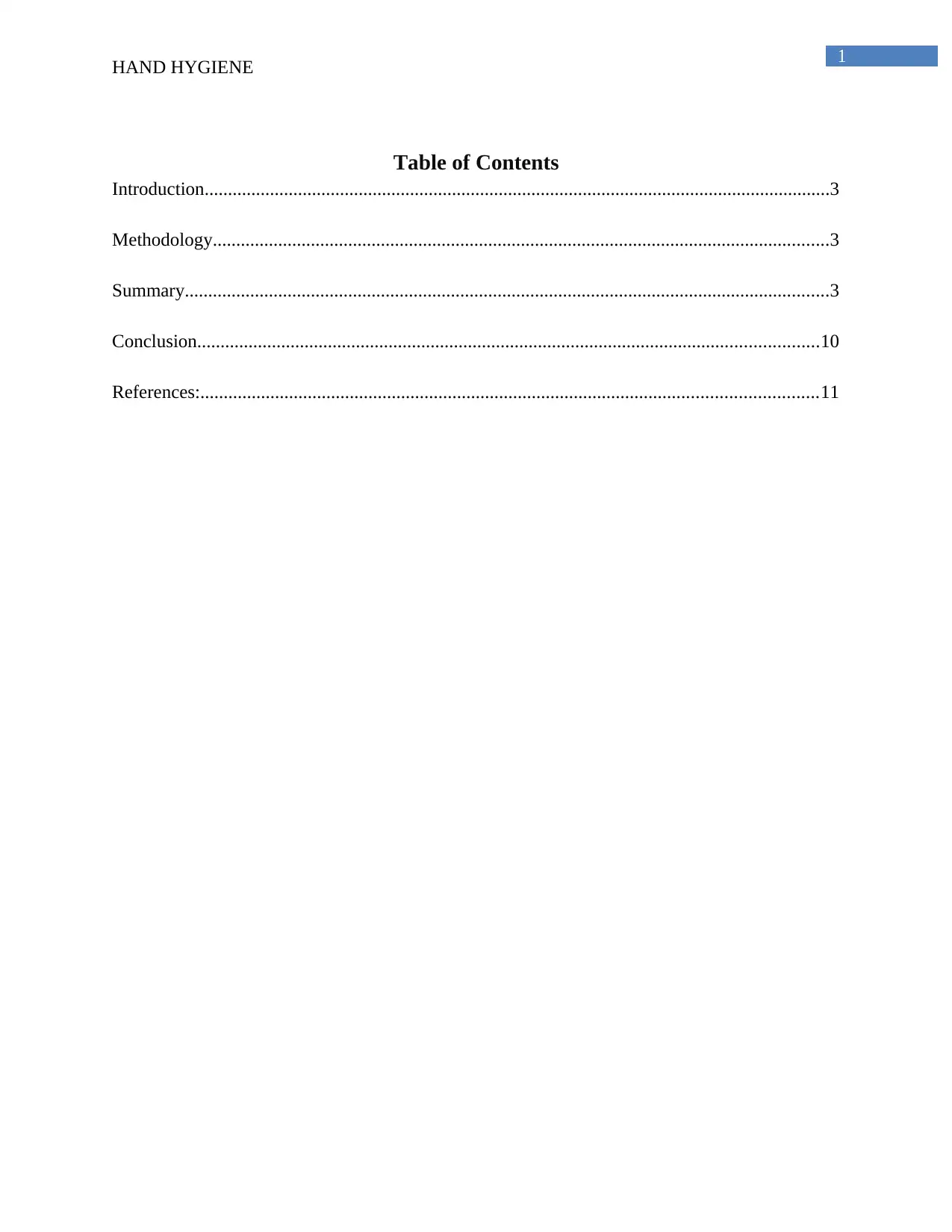
1
HAND HYGIENE
Table of Contents
Introduction......................................................................................................................................3
Methodology....................................................................................................................................3
Summary..........................................................................................................................................3
Conclusion.....................................................................................................................................10
References:....................................................................................................................................11
HAND HYGIENE
Table of Contents
Introduction......................................................................................................................................3
Methodology....................................................................................................................................3
Summary..........................................................................................................................................3
Conclusion.....................................................................................................................................10
References:....................................................................................................................................11
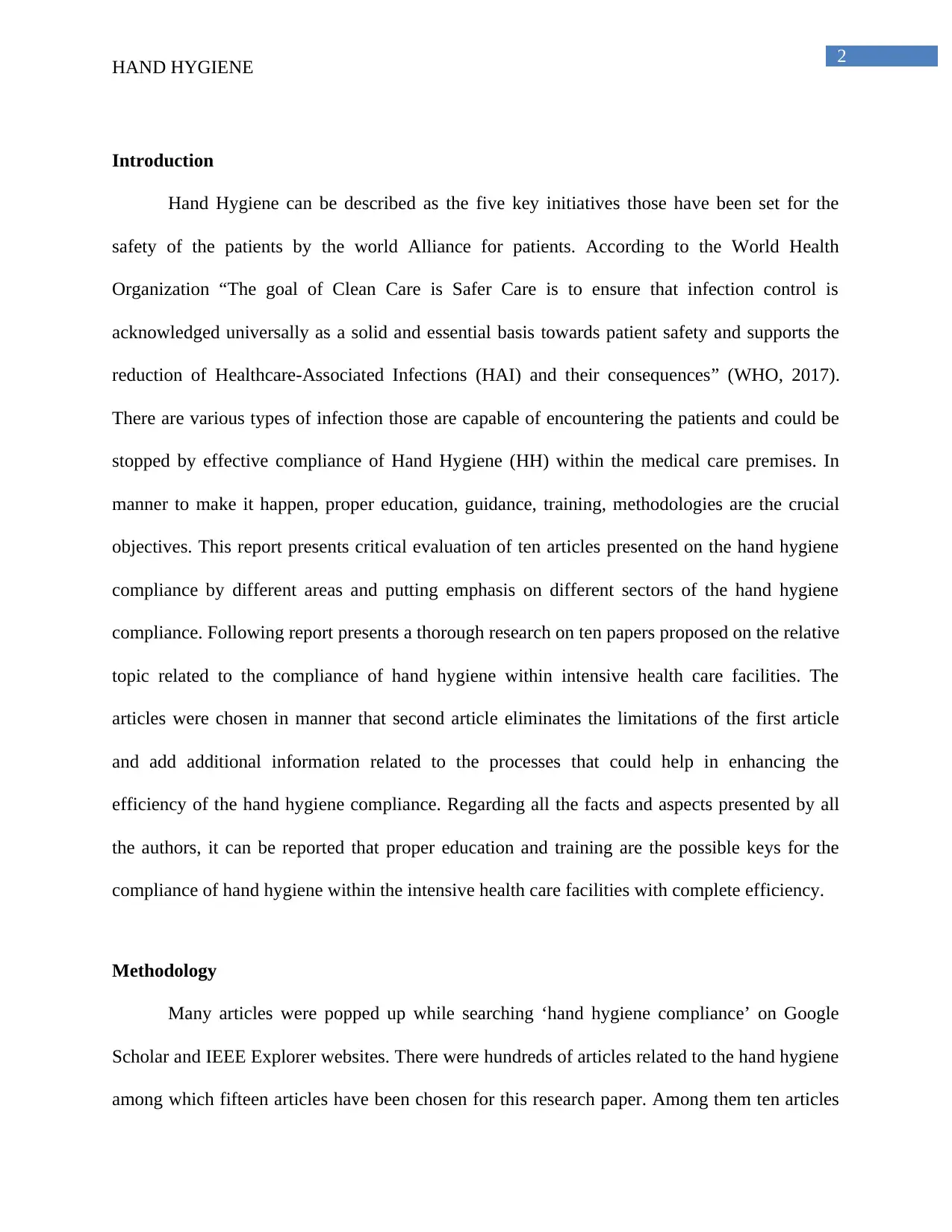
2
HAND HYGIENE
Introduction
Hand Hygiene can be described as the five key initiatives those have been set for the
safety of the patients by the world Alliance for patients. According to the World Health
Organization “The goal of Clean Care is Safer Care is to ensure that infection control is
acknowledged universally as a solid and essential basis towards patient safety and supports the
reduction of Healthcare-Associated Infections (HAI) and their consequences” (WHO, 2017).
There are various types of infection those are capable of encountering the patients and could be
stopped by effective compliance of Hand Hygiene (HH) within the medical care premises. In
manner to make it happen, proper education, guidance, training, methodologies are the crucial
objectives. This report presents critical evaluation of ten articles presented on the hand hygiene
compliance by different areas and putting emphasis on different sectors of the hand hygiene
compliance. Following report presents a thorough research on ten papers proposed on the relative
topic related to the compliance of hand hygiene within intensive health care facilities. The
articles were chosen in manner that second article eliminates the limitations of the first article
and add additional information related to the processes that could help in enhancing the
efficiency of the hand hygiene compliance. Regarding all the facts and aspects presented by all
the authors, it can be reported that proper education and training are the possible keys for the
compliance of hand hygiene within the intensive health care facilities with complete efficiency.
Methodology
Many articles were popped up while searching ‘hand hygiene compliance’ on Google
Scholar and IEEE Explorer websites. There were hundreds of articles related to the hand hygiene
among which fifteen articles have been chosen for this research paper. Among them ten articles
HAND HYGIENE
Introduction
Hand Hygiene can be described as the five key initiatives those have been set for the
safety of the patients by the world Alliance for patients. According to the World Health
Organization “The goal of Clean Care is Safer Care is to ensure that infection control is
acknowledged universally as a solid and essential basis towards patient safety and supports the
reduction of Healthcare-Associated Infections (HAI) and their consequences” (WHO, 2017).
There are various types of infection those are capable of encountering the patients and could be
stopped by effective compliance of Hand Hygiene (HH) within the medical care premises. In
manner to make it happen, proper education, guidance, training, methodologies are the crucial
objectives. This report presents critical evaluation of ten articles presented on the hand hygiene
compliance by different areas and putting emphasis on different sectors of the hand hygiene
compliance. Following report presents a thorough research on ten papers proposed on the relative
topic related to the compliance of hand hygiene within intensive health care facilities. The
articles were chosen in manner that second article eliminates the limitations of the first article
and add additional information related to the processes that could help in enhancing the
efficiency of the hand hygiene compliance. Regarding all the facts and aspects presented by all
the authors, it can be reported that proper education and training are the possible keys for the
compliance of hand hygiene within the intensive health care facilities with complete efficiency.
Methodology
Many articles were popped up while searching ‘hand hygiene compliance’ on Google
Scholar and IEEE Explorer websites. There were hundreds of articles related to the hand hygiene
among which fifteen articles have been chosen for this research paper. Among them ten articles
⊘ This is a preview!⊘
Do you want full access?
Subscribe today to unlock all pages.

Trusted by 1+ million students worldwide
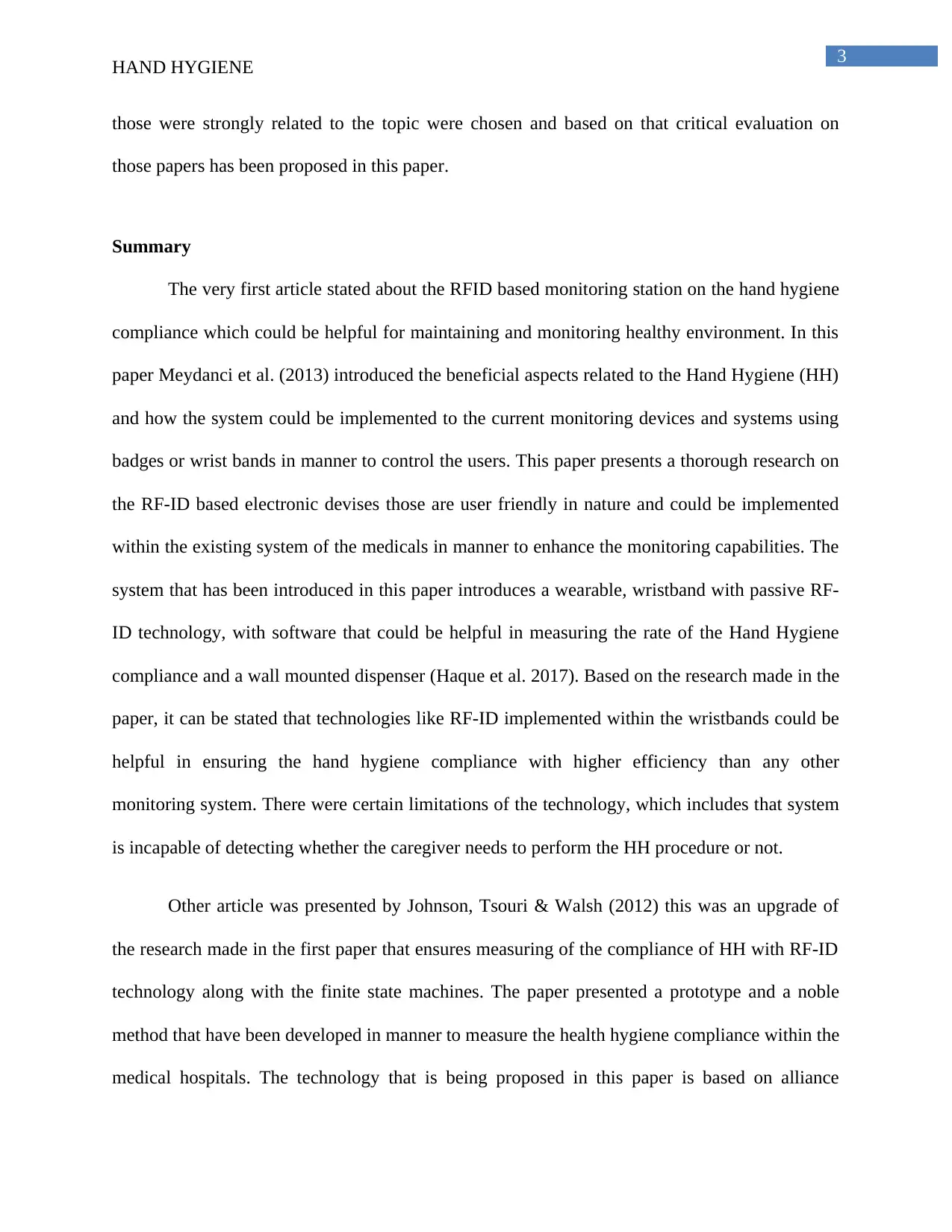
3
HAND HYGIENE
those were strongly related to the topic were chosen and based on that critical evaluation on
those papers has been proposed in this paper.
Summary
The very first article stated about the RFID based monitoring station on the hand hygiene
compliance which could be helpful for maintaining and monitoring healthy environment. In this
paper Meydanci et al. (2013) introduced the beneficial aspects related to the Hand Hygiene (HH)
and how the system could be implemented to the current monitoring devices and systems using
badges or wrist bands in manner to control the users. This paper presents a thorough research on
the RF-ID based electronic devises those are user friendly in nature and could be implemented
within the existing system of the medicals in manner to enhance the monitoring capabilities. The
system that has been introduced in this paper introduces a wearable, wristband with passive RF-
ID technology, with software that could be helpful in measuring the rate of the Hand Hygiene
compliance and a wall mounted dispenser (Haque et al. 2017). Based on the research made in the
paper, it can be stated that technologies like RF-ID implemented within the wristbands could be
helpful in ensuring the hand hygiene compliance with higher efficiency than any other
monitoring system. There were certain limitations of the technology, which includes that system
is incapable of detecting whether the caregiver needs to perform the HH procedure or not.
Other article was presented by Johnson, Tsouri & Walsh (2012) this was an upgrade of
the research made in the first paper that ensures measuring of the compliance of HH with RF-ID
technology along with the finite state machines. The paper presented a prototype and a noble
method that have been developed in manner to measure the health hygiene compliance within the
medical hospitals. The technology that is being proposed in this paper is based on alliance
HAND HYGIENE
those were strongly related to the topic were chosen and based on that critical evaluation on
those papers has been proposed in this paper.
Summary
The very first article stated about the RFID based monitoring station on the hand hygiene
compliance which could be helpful for maintaining and monitoring healthy environment. In this
paper Meydanci et al. (2013) introduced the beneficial aspects related to the Hand Hygiene (HH)
and how the system could be implemented to the current monitoring devices and systems using
badges or wrist bands in manner to control the users. This paper presents a thorough research on
the RF-ID based electronic devises those are user friendly in nature and could be implemented
within the existing system of the medicals in manner to enhance the monitoring capabilities. The
system that has been introduced in this paper introduces a wearable, wristband with passive RF-
ID technology, with software that could be helpful in measuring the rate of the Hand Hygiene
compliance and a wall mounted dispenser (Haque et al. 2017). Based on the research made in the
paper, it can be stated that technologies like RF-ID implemented within the wristbands could be
helpful in ensuring the hand hygiene compliance with higher efficiency than any other
monitoring system. There were certain limitations of the technology, which includes that system
is incapable of detecting whether the caregiver needs to perform the HH procedure or not.
Other article was presented by Johnson, Tsouri & Walsh (2012) this was an upgrade of
the research made in the first paper that ensures measuring of the compliance of HH with RF-ID
technology along with the finite state machines. The paper presented a prototype and a noble
method that have been developed in manner to measure the health hygiene compliance within the
medical hospitals. The technology that is being proposed in this paper is based on alliance
Paraphrase This Document
Need a fresh take? Get an instant paraphrase of this document with our AI Paraphraser
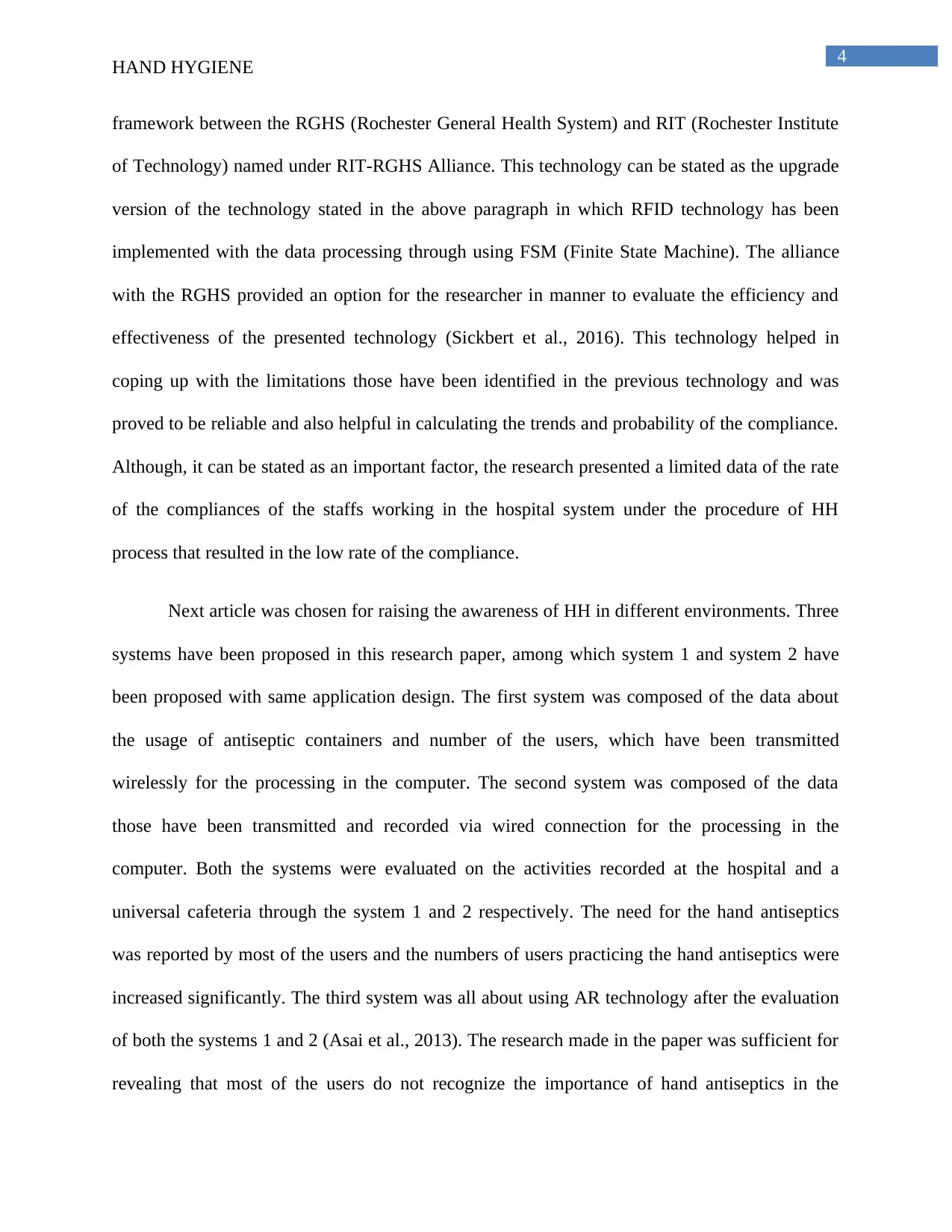
4
HAND HYGIENE
framework between the RGHS (Rochester General Health System) and RIT (Rochester Institute
of Technology) named under RIT-RGHS Alliance. This technology can be stated as the upgrade
version of the technology stated in the above paragraph in which RFID technology has been
implemented with the data processing through using FSM (Finite State Machine). The alliance
with the RGHS provided an option for the researcher in manner to evaluate the efficiency and
effectiveness of the presented technology (Sickbert et al., 2016). This technology helped in
coping up with the limitations those have been identified in the previous technology and was
proved to be reliable and also helpful in calculating the trends and probability of the compliance.
Although, it can be stated as an important factor, the research presented a limited data of the rate
of the compliances of the staffs working in the hospital system under the procedure of HH
process that resulted in the low rate of the compliance.
Next article was chosen for raising the awareness of HH in different environments. Three
systems have been proposed in this research paper, among which system 1 and system 2 have
been proposed with same application design. The first system was composed of the data about
the usage of antiseptic containers and number of the users, which have been transmitted
wirelessly for the processing in the computer. The second system was composed of the data
those have been transmitted and recorded via wired connection for the processing in the
computer. Both the systems were evaluated on the activities recorded at the hospital and a
universal cafeteria through the system 1 and 2 respectively. The need for the hand antiseptics
was reported by most of the users and the numbers of users practicing the hand antiseptics were
increased significantly. The third system was all about using AR technology after the evaluation
of both the systems 1 and 2 (Asai et al., 2013). The research made in the paper was sufficient for
revealing that most of the users do not recognize the importance of hand antiseptics in the
HAND HYGIENE
framework between the RGHS (Rochester General Health System) and RIT (Rochester Institute
of Technology) named under RIT-RGHS Alliance. This technology can be stated as the upgrade
version of the technology stated in the above paragraph in which RFID technology has been
implemented with the data processing through using FSM (Finite State Machine). The alliance
with the RGHS provided an option for the researcher in manner to evaluate the efficiency and
effectiveness of the presented technology (Sickbert et al., 2016). This technology helped in
coping up with the limitations those have been identified in the previous technology and was
proved to be reliable and also helpful in calculating the trends and probability of the compliance.
Although, it can be stated as an important factor, the research presented a limited data of the rate
of the compliances of the staffs working in the hospital system under the procedure of HH
process that resulted in the low rate of the compliance.
Next article was chosen for raising the awareness of HH in different environments. Three
systems have been proposed in this research paper, among which system 1 and system 2 have
been proposed with same application design. The first system was composed of the data about
the usage of antiseptic containers and number of the users, which have been transmitted
wirelessly for the processing in the computer. The second system was composed of the data
those have been transmitted and recorded via wired connection for the processing in the
computer. Both the systems were evaluated on the activities recorded at the hospital and a
universal cafeteria through the system 1 and 2 respectively. The need for the hand antiseptics
was reported by most of the users and the numbers of users practicing the hand antiseptics were
increased significantly. The third system was all about using AR technology after the evaluation
of both the systems 1 and 2 (Asai et al., 2013). The research made in the paper was sufficient for
revealing that most of the users do not recognize the importance of hand antiseptics in the
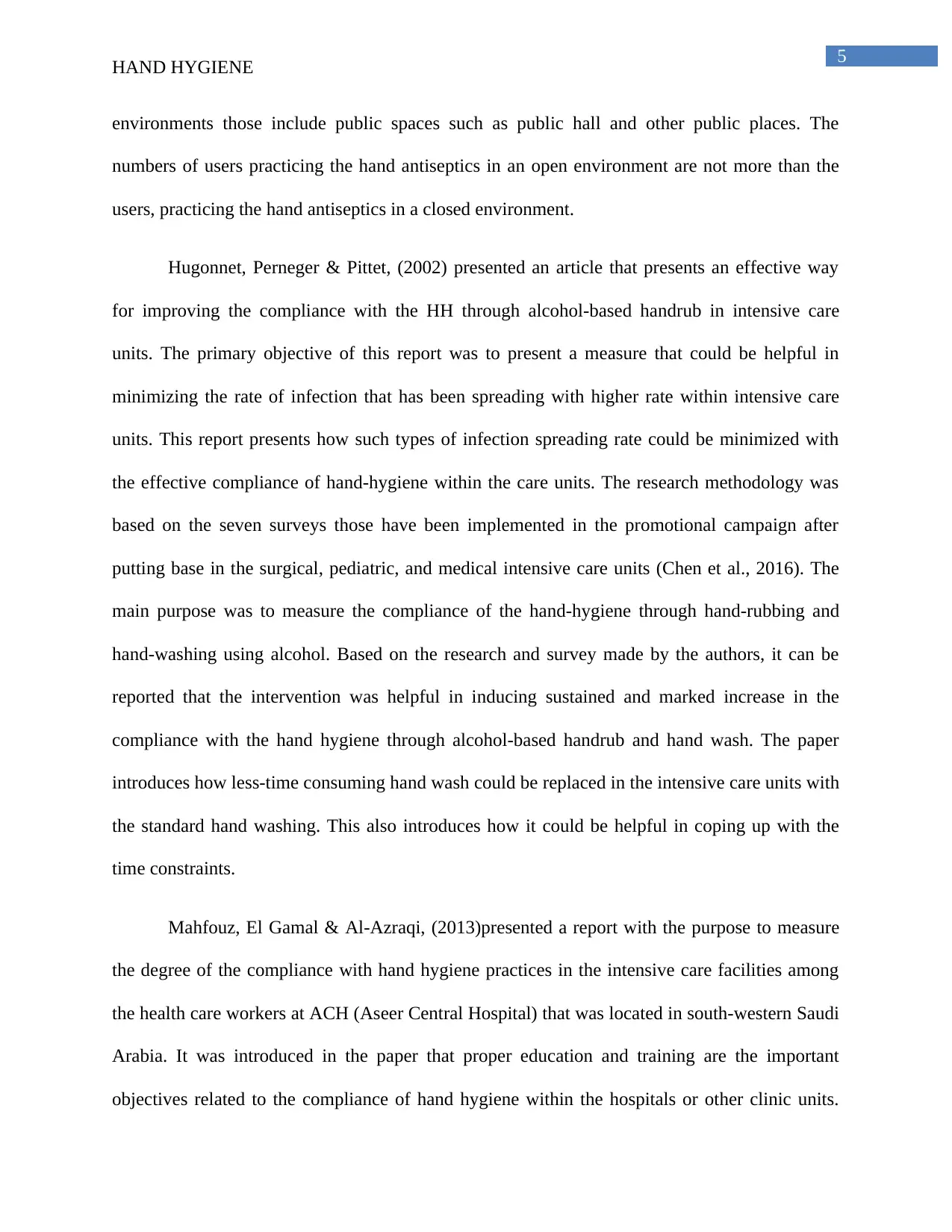
5
HAND HYGIENE
environments those include public spaces such as public hall and other public places. The
numbers of users practicing the hand antiseptics in an open environment are not more than the
users, practicing the hand antiseptics in a closed environment.
Hugonnet, Perneger & Pittet, (2002) presented an article that presents an effective way
for improving the compliance with the HH through alcohol-based handrub in intensive care
units. The primary objective of this report was to present a measure that could be helpful in
minimizing the rate of infection that has been spreading with higher rate within intensive care
units. This report presents how such types of infection spreading rate could be minimized with
the effective compliance of hand-hygiene within the care units. The research methodology was
based on the seven surveys those have been implemented in the promotional campaign after
putting base in the surgical, pediatric, and medical intensive care units (Chen et al., 2016). The
main purpose was to measure the compliance of the hand-hygiene through hand-rubbing and
hand-washing using alcohol. Based on the research and survey made by the authors, it can be
reported that the intervention was helpful in inducing sustained and marked increase in the
compliance with the hand hygiene through alcohol-based handrub and hand wash. The paper
introduces how less-time consuming hand wash could be replaced in the intensive care units with
the standard hand washing. This also introduces how it could be helpful in coping up with the
time constraints.
Mahfouz, El Gamal & Al-Azraqi, (2013)presented a report with the purpose to measure
the degree of the compliance with hand hygiene practices in the intensive care facilities among
the health care workers at ACH (Aseer Central Hospital) that was located in south-western Saudi
Arabia. It was introduced in the paper that proper education and training are the important
objectives related to the compliance of hand hygiene within the hospitals or other clinic units.
HAND HYGIENE
environments those include public spaces such as public hall and other public places. The
numbers of users practicing the hand antiseptics in an open environment are not more than the
users, practicing the hand antiseptics in a closed environment.
Hugonnet, Perneger & Pittet, (2002) presented an article that presents an effective way
for improving the compliance with the HH through alcohol-based handrub in intensive care
units. The primary objective of this report was to present a measure that could be helpful in
minimizing the rate of infection that has been spreading with higher rate within intensive care
units. This report presents how such types of infection spreading rate could be minimized with
the effective compliance of hand-hygiene within the care units. The research methodology was
based on the seven surveys those have been implemented in the promotional campaign after
putting base in the surgical, pediatric, and medical intensive care units (Chen et al., 2016). The
main purpose was to measure the compliance of the hand-hygiene through hand-rubbing and
hand-washing using alcohol. Based on the research and survey made by the authors, it can be
reported that the intervention was helpful in inducing sustained and marked increase in the
compliance with the hand hygiene through alcohol-based handrub and hand wash. The paper
introduces how less-time consuming hand wash could be replaced in the intensive care units with
the standard hand washing. This also introduces how it could be helpful in coping up with the
time constraints.
Mahfouz, El Gamal & Al-Azraqi, (2013)presented a report with the purpose to measure
the degree of the compliance with hand hygiene practices in the intensive care facilities among
the health care workers at ACH (Aseer Central Hospital) that was located in south-western Saudi
Arabia. It was introduced in the paper that proper education and training are the important
objectives related to the compliance of hand hygiene within the hospitals or other clinic units.
⊘ This is a preview!⊘
Do you want full access?
Subscribe today to unlock all pages.

Trusted by 1+ million students worldwide
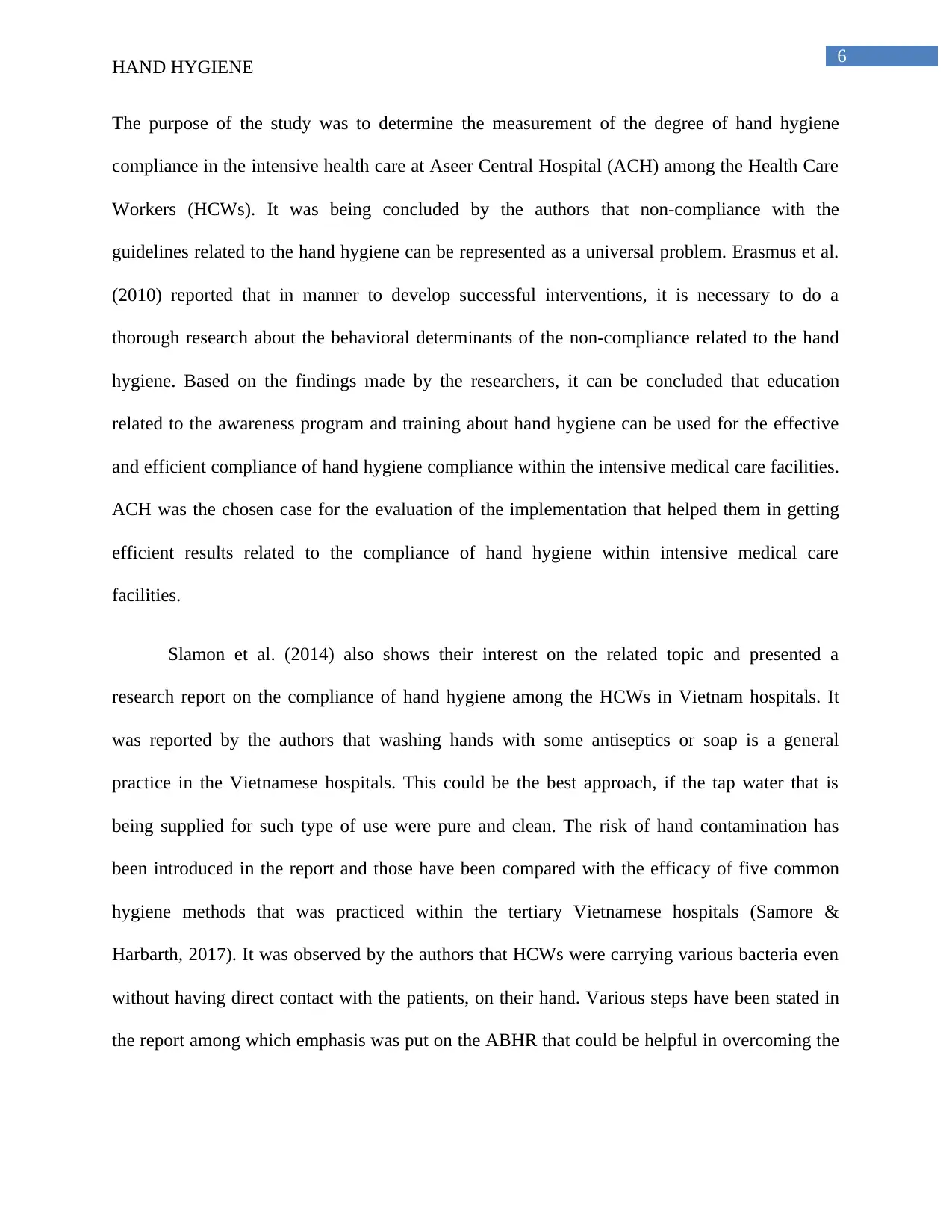
6
HAND HYGIENE
The purpose of the study was to determine the measurement of the degree of hand hygiene
compliance in the intensive health care at Aseer Central Hospital (ACH) among the Health Care
Workers (HCWs). It was being concluded by the authors that non-compliance with the
guidelines related to the hand hygiene can be represented as a universal problem. Erasmus et al.
(2010) reported that in manner to develop successful interventions, it is necessary to do a
thorough research about the behavioral determinants of the non-compliance related to the hand
hygiene. Based on the findings made by the researchers, it can be concluded that education
related to the awareness program and training about hand hygiene can be used for the effective
and efficient compliance of hand hygiene compliance within the intensive medical care facilities.
ACH was the chosen case for the evaluation of the implementation that helped them in getting
efficient results related to the compliance of hand hygiene within intensive medical care
facilities.
Slamon et al. (2014) also shows their interest on the related topic and presented a
research report on the compliance of hand hygiene among the HCWs in Vietnam hospitals. It
was reported by the authors that washing hands with some antiseptics or soap is a general
practice in the Vietnamese hospitals. This could be the best approach, if the tap water that is
being supplied for such type of use were pure and clean. The risk of hand contamination has
been introduced in the report and those have been compared with the efficacy of five common
hygiene methods that was practiced within the tertiary Vietnamese hospitals (Samore &
Harbarth, 2017). It was observed by the authors that HCWs were carrying various bacteria even
without having direct contact with the patients, on their hand. Various steps have been stated in
the report among which emphasis was put on the ABHR that could be helpful in overcoming the
HAND HYGIENE
The purpose of the study was to determine the measurement of the degree of hand hygiene
compliance in the intensive health care at Aseer Central Hospital (ACH) among the Health Care
Workers (HCWs). It was being concluded by the authors that non-compliance with the
guidelines related to the hand hygiene can be represented as a universal problem. Erasmus et al.
(2010) reported that in manner to develop successful interventions, it is necessary to do a
thorough research about the behavioral determinants of the non-compliance related to the hand
hygiene. Based on the findings made by the researchers, it can be concluded that education
related to the awareness program and training about hand hygiene can be used for the effective
and efficient compliance of hand hygiene compliance within the intensive medical care facilities.
ACH was the chosen case for the evaluation of the implementation that helped them in getting
efficient results related to the compliance of hand hygiene within intensive medical care
facilities.
Slamon et al. (2014) also shows their interest on the related topic and presented a
research report on the compliance of hand hygiene among the HCWs in Vietnam hospitals. It
was reported by the authors that washing hands with some antiseptics or soap is a general
practice in the Vietnamese hospitals. This could be the best approach, if the tap water that is
being supplied for such type of use were pure and clean. The risk of hand contamination has
been introduced in the report and those have been compared with the efficacy of five common
hygiene methods that was practiced within the tertiary Vietnamese hospitals (Samore &
Harbarth, 2017). It was observed by the authors that HCWs were carrying various bacteria even
without having direct contact with the patients, on their hand. Various steps have been stated in
the report among which emphasis was put on the ABHR that could be helpful in overcoming the
Paraphrase This Document
Need a fresh take? Get an instant paraphrase of this document with our AI Paraphraser
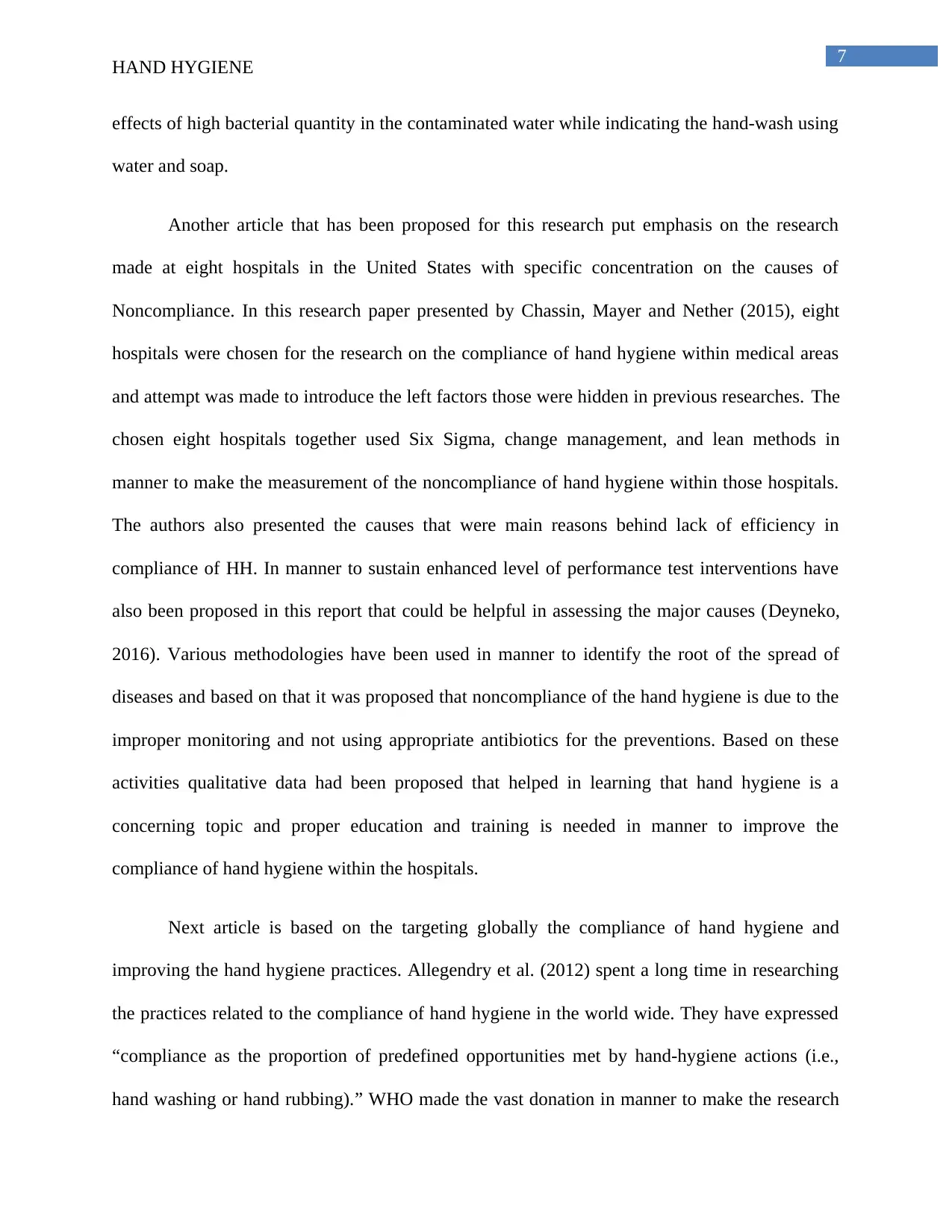
7
HAND HYGIENE
effects of high bacterial quantity in the contaminated water while indicating the hand-wash using
water and soap.
Another article that has been proposed for this research put emphasis on the research
made at eight hospitals in the United States with specific concentration on the causes of
Noncompliance. In this research paper presented by Chassin, Mayer and Nether (2015), eight
hospitals were chosen for the research on the compliance of hand hygiene within medical areas
and attempt was made to introduce the left factors those were hidden in previous researches. The
chosen eight hospitals together used Six Sigma, change management, and lean methods in
manner to make the measurement of the noncompliance of hand hygiene within those hospitals.
The authors also presented the causes that were main reasons behind lack of efficiency in
compliance of HH. In manner to sustain enhanced level of performance test interventions have
also been proposed in this report that could be helpful in assessing the major causes (Deyneko,
2016). Various methodologies have been used in manner to identify the root of the spread of
diseases and based on that it was proposed that noncompliance of the hand hygiene is due to the
improper monitoring and not using appropriate antibiotics for the preventions. Based on these
activities qualitative data had been proposed that helped in learning that hand hygiene is a
concerning topic and proper education and training is needed in manner to improve the
compliance of hand hygiene within the hospitals.
Next article is based on the targeting globally the compliance of hand hygiene and
improving the hand hygiene practices. Allegendry et al. (2012) spent a long time in researching
the practices related to the compliance of hand hygiene in the world wide. They have expressed
“compliance as the proportion of predefined opportunities met by hand-hygiene actions (i.e.,
hand washing or hand rubbing).” WHO made the vast donation in manner to make the research
HAND HYGIENE
effects of high bacterial quantity in the contaminated water while indicating the hand-wash using
water and soap.
Another article that has been proposed for this research put emphasis on the research
made at eight hospitals in the United States with specific concentration on the causes of
Noncompliance. In this research paper presented by Chassin, Mayer and Nether (2015), eight
hospitals were chosen for the research on the compliance of hand hygiene within medical areas
and attempt was made to introduce the left factors those were hidden in previous researches. The
chosen eight hospitals together used Six Sigma, change management, and lean methods in
manner to make the measurement of the noncompliance of hand hygiene within those hospitals.
The authors also presented the causes that were main reasons behind lack of efficiency in
compliance of HH. In manner to sustain enhanced level of performance test interventions have
also been proposed in this report that could be helpful in assessing the major causes (Deyneko,
2016). Various methodologies have been used in manner to identify the root of the spread of
diseases and based on that it was proposed that noncompliance of the hand hygiene is due to the
improper monitoring and not using appropriate antibiotics for the preventions. Based on these
activities qualitative data had been proposed that helped in learning that hand hygiene is a
concerning topic and proper education and training is needed in manner to improve the
compliance of hand hygiene within the hospitals.
Next article is based on the targeting globally the compliance of hand hygiene and
improving the hand hygiene practices. Allegendry et al. (2012) spent a long time in researching
the practices related to the compliance of hand hygiene in the world wide. They have expressed
“compliance as the proportion of predefined opportunities met by hand-hygiene actions (i.e.,
hand washing or hand rubbing).” WHO made the vast donation in manner to make the research
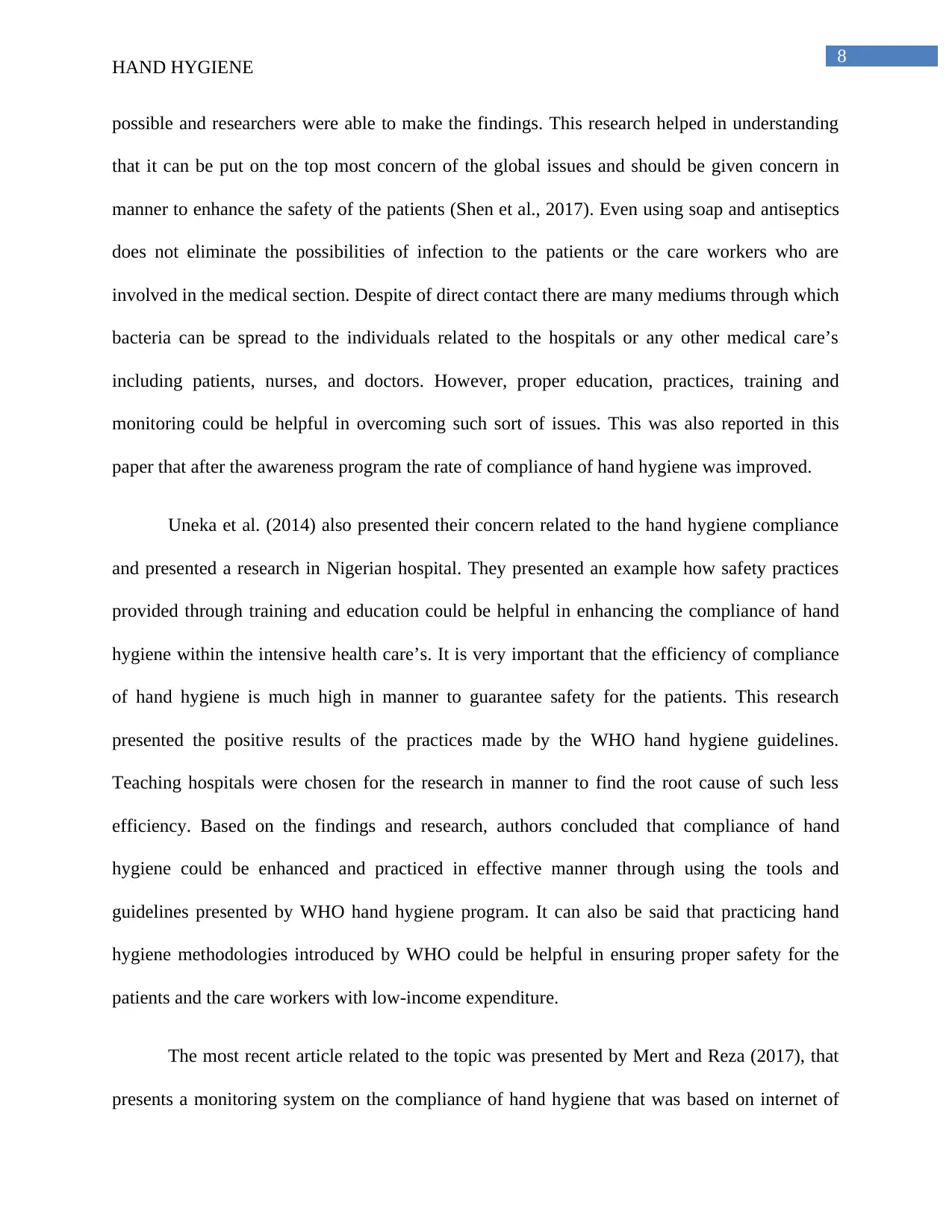
8
HAND HYGIENE
possible and researchers were able to make the findings. This research helped in understanding
that it can be put on the top most concern of the global issues and should be given concern in
manner to enhance the safety of the patients (Shen et al., 2017). Even using soap and antiseptics
does not eliminate the possibilities of infection to the patients or the care workers who are
involved in the medical section. Despite of direct contact there are many mediums through which
bacteria can be spread to the individuals related to the hospitals or any other medical care’s
including patients, nurses, and doctors. However, proper education, practices, training and
monitoring could be helpful in overcoming such sort of issues. This was also reported in this
paper that after the awareness program the rate of compliance of hand hygiene was improved.
Uneka et al. (2014) also presented their concern related to the hand hygiene compliance
and presented a research in Nigerian hospital. They presented an example how safety practices
provided through training and education could be helpful in enhancing the compliance of hand
hygiene within the intensive health care’s. It is very important that the efficiency of compliance
of hand hygiene is much high in manner to guarantee safety for the patients. This research
presented the positive results of the practices made by the WHO hand hygiene guidelines.
Teaching hospitals were chosen for the research in manner to find the root cause of such less
efficiency. Based on the findings and research, authors concluded that compliance of hand
hygiene could be enhanced and practiced in effective manner through using the tools and
guidelines presented by WHO hand hygiene program. It can also be said that practicing hand
hygiene methodologies introduced by WHO could be helpful in ensuring proper safety for the
patients and the care workers with low-income expenditure.
The most recent article related to the topic was presented by Mert and Reza (2017), that
presents a monitoring system on the compliance of hand hygiene that was based on internet of
HAND HYGIENE
possible and researchers were able to make the findings. This research helped in understanding
that it can be put on the top most concern of the global issues and should be given concern in
manner to enhance the safety of the patients (Shen et al., 2017). Even using soap and antiseptics
does not eliminate the possibilities of infection to the patients or the care workers who are
involved in the medical section. Despite of direct contact there are many mediums through which
bacteria can be spread to the individuals related to the hospitals or any other medical care’s
including patients, nurses, and doctors. However, proper education, practices, training and
monitoring could be helpful in overcoming such sort of issues. This was also reported in this
paper that after the awareness program the rate of compliance of hand hygiene was improved.
Uneka et al. (2014) also presented their concern related to the hand hygiene compliance
and presented a research in Nigerian hospital. They presented an example how safety practices
provided through training and education could be helpful in enhancing the compliance of hand
hygiene within the intensive health care’s. It is very important that the efficiency of compliance
of hand hygiene is much high in manner to guarantee safety for the patients. This research
presented the positive results of the practices made by the WHO hand hygiene guidelines.
Teaching hospitals were chosen for the research in manner to find the root cause of such less
efficiency. Based on the findings and research, authors concluded that compliance of hand
hygiene could be enhanced and practiced in effective manner through using the tools and
guidelines presented by WHO hand hygiene program. It can also be said that practicing hand
hygiene methodologies introduced by WHO could be helpful in ensuring proper safety for the
patients and the care workers with low-income expenditure.
The most recent article related to the topic was presented by Mert and Reza (2017), that
presents a monitoring system on the compliance of hand hygiene that was based on internet of
⊘ This is a preview!⊘
Do you want full access?
Subscribe today to unlock all pages.

Trusted by 1+ million students worldwide
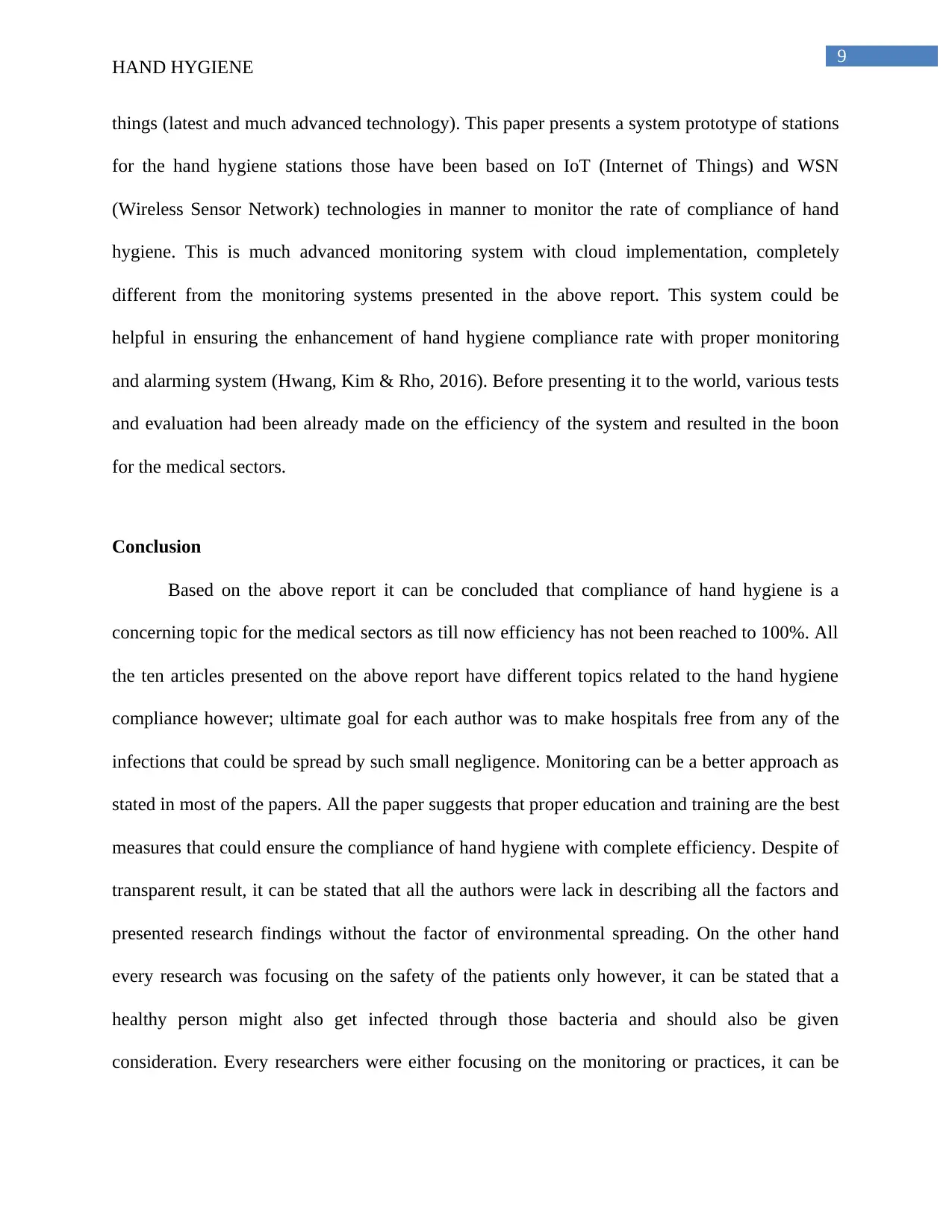
9
HAND HYGIENE
things (latest and much advanced technology). This paper presents a system prototype of stations
for the hand hygiene stations those have been based on IoT (Internet of Things) and WSN
(Wireless Sensor Network) technologies in manner to monitor the rate of compliance of hand
hygiene. This is much advanced monitoring system with cloud implementation, completely
different from the monitoring systems presented in the above report. This system could be
helpful in ensuring the enhancement of hand hygiene compliance rate with proper monitoring
and alarming system (Hwang, Kim & Rho, 2016). Before presenting it to the world, various tests
and evaluation had been already made on the efficiency of the system and resulted in the boon
for the medical sectors.
Conclusion
Based on the above report it can be concluded that compliance of hand hygiene is a
concerning topic for the medical sectors as till now efficiency has not been reached to 100%. All
the ten articles presented on the above report have different topics related to the hand hygiene
compliance however; ultimate goal for each author was to make hospitals free from any of the
infections that could be spread by such small negligence. Monitoring can be a better approach as
stated in most of the papers. All the paper suggests that proper education and training are the best
measures that could ensure the compliance of hand hygiene with complete efficiency. Despite of
transparent result, it can be stated that all the authors were lack in describing all the factors and
presented research findings without the factor of environmental spreading. On the other hand
every research was focusing on the safety of the patients only however, it can be stated that a
healthy person might also get infected through those bacteria and should also be given
consideration. Every researchers were either focusing on the monitoring or practices, it can be
HAND HYGIENE
things (latest and much advanced technology). This paper presents a system prototype of stations
for the hand hygiene stations those have been based on IoT (Internet of Things) and WSN
(Wireless Sensor Network) technologies in manner to monitor the rate of compliance of hand
hygiene. This is much advanced monitoring system with cloud implementation, completely
different from the monitoring systems presented in the above report. This system could be
helpful in ensuring the enhancement of hand hygiene compliance rate with proper monitoring
and alarming system (Hwang, Kim & Rho, 2016). Before presenting it to the world, various tests
and evaluation had been already made on the efficiency of the system and resulted in the boon
for the medical sectors.
Conclusion
Based on the above report it can be concluded that compliance of hand hygiene is a
concerning topic for the medical sectors as till now efficiency has not been reached to 100%. All
the ten articles presented on the above report have different topics related to the hand hygiene
compliance however; ultimate goal for each author was to make hospitals free from any of the
infections that could be spread by such small negligence. Monitoring can be a better approach as
stated in most of the papers. All the paper suggests that proper education and training are the best
measures that could ensure the compliance of hand hygiene with complete efficiency. Despite of
transparent result, it can be stated that all the authors were lack in describing all the factors and
presented research findings without the factor of environmental spreading. On the other hand
every research was focusing on the safety of the patients only however, it can be stated that a
healthy person might also get infected through those bacteria and should also be given
consideration. Every researchers were either focusing on the monitoring or practices, it can be
Paraphrase This Document
Need a fresh take? Get an instant paraphrase of this document with our AI Paraphraser

10
HAND HYGIENE
recommended that indulging both the topics in a single research could result in effective and
efficient compliance of hand hygiene within the intensive health care facilities.
HAND HYGIENE
recommended that indulging both the topics in a single research could result in effective and
efficient compliance of hand hygiene within the intensive health care facilities.
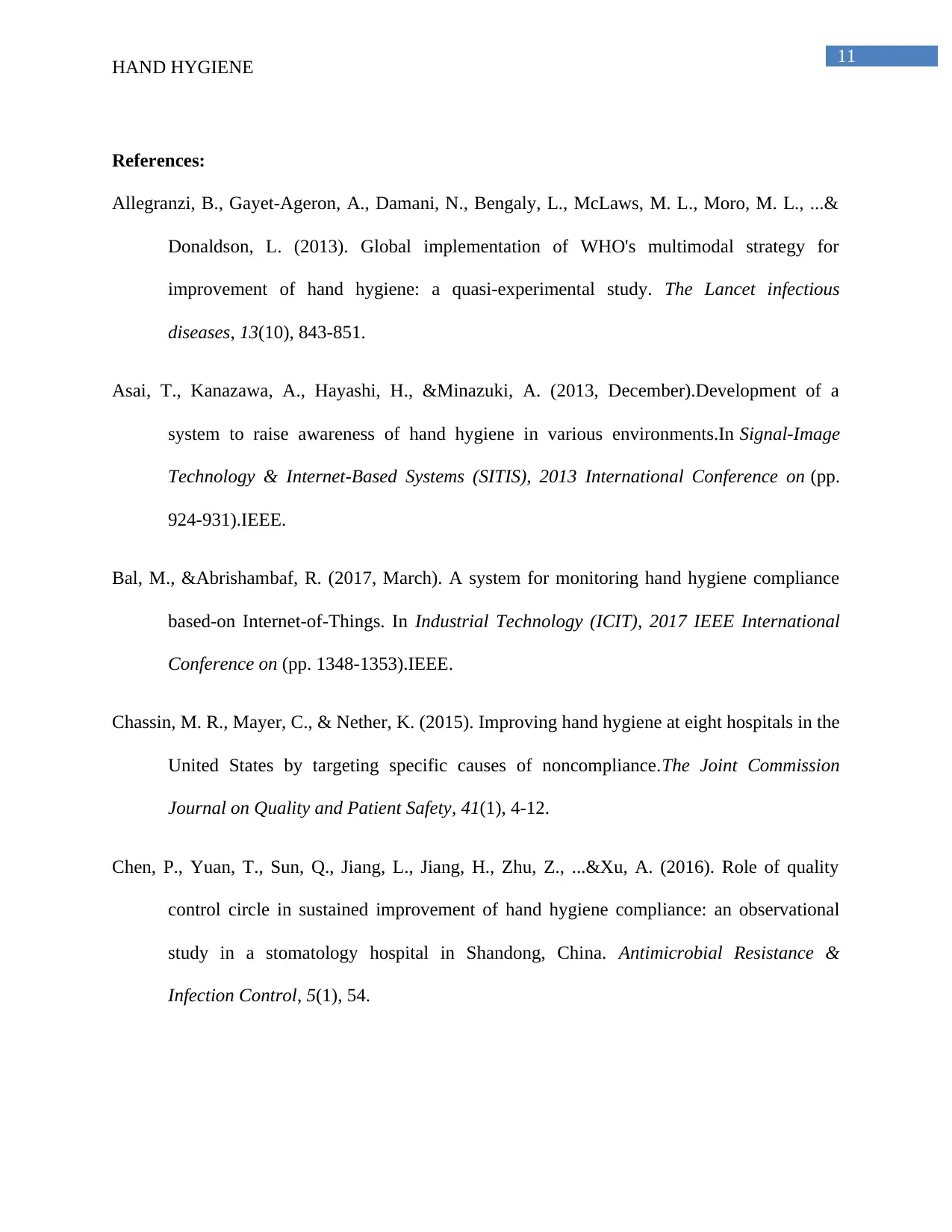
11
HAND HYGIENE
References:
Allegranzi, B., Gayet-Ageron, A., Damani, N., Bengaly, L., McLaws, M. L., Moro, M. L., ...&
Donaldson, L. (2013). Global implementation of WHO's multimodal strategy for
improvement of hand hygiene: a quasi-experimental study. The Lancet infectious
diseases, 13(10), 843-851.
Asai, T., Kanazawa, A., Hayashi, H., &Minazuki, A. (2013, December).Development of a
system to raise awareness of hand hygiene in various environments.In Signal-Image
Technology & Internet-Based Systems (SITIS), 2013 International Conference on (pp.
924-931).IEEE.
Bal, M., &Abrishambaf, R. (2017, March). A system for monitoring hand hygiene compliance
based-on Internet-of-Things. In Industrial Technology (ICIT), 2017 IEEE International
Conference on (pp. 1348-1353).IEEE.
Chassin, M. R., Mayer, C., & Nether, K. (2015). Improving hand hygiene at eight hospitals in the
United States by targeting specific causes of noncompliance.The Joint Commission
Journal on Quality and Patient Safety, 41(1), 4-12.
Chen, P., Yuan, T., Sun, Q., Jiang, L., Jiang, H., Zhu, Z., ...&Xu, A. (2016). Role of quality
control circle in sustained improvement of hand hygiene compliance: an observational
study in a stomatology hospital in Shandong, China. Antimicrobial Resistance &
Infection Control, 5(1), 54.
HAND HYGIENE
References:
Allegranzi, B., Gayet-Ageron, A., Damani, N., Bengaly, L., McLaws, M. L., Moro, M. L., ...&
Donaldson, L. (2013). Global implementation of WHO's multimodal strategy for
improvement of hand hygiene: a quasi-experimental study. The Lancet infectious
diseases, 13(10), 843-851.
Asai, T., Kanazawa, A., Hayashi, H., &Minazuki, A. (2013, December).Development of a
system to raise awareness of hand hygiene in various environments.In Signal-Image
Technology & Internet-Based Systems (SITIS), 2013 International Conference on (pp.
924-931).IEEE.
Bal, M., &Abrishambaf, R. (2017, March). A system for monitoring hand hygiene compliance
based-on Internet-of-Things. In Industrial Technology (ICIT), 2017 IEEE International
Conference on (pp. 1348-1353).IEEE.
Chassin, M. R., Mayer, C., & Nether, K. (2015). Improving hand hygiene at eight hospitals in the
United States by targeting specific causes of noncompliance.The Joint Commission
Journal on Quality and Patient Safety, 41(1), 4-12.
Chen, P., Yuan, T., Sun, Q., Jiang, L., Jiang, H., Zhu, Z., ...&Xu, A. (2016). Role of quality
control circle in sustained improvement of hand hygiene compliance: an observational
study in a stomatology hospital in Shandong, China. Antimicrobial Resistance &
Infection Control, 5(1), 54.
⊘ This is a preview!⊘
Do you want full access?
Subscribe today to unlock all pages.

Trusted by 1+ million students worldwide
1 out of 15
Related Documents
Your All-in-One AI-Powered Toolkit for Academic Success.
+13062052269
info@desklib.com
Available 24*7 on WhatsApp / Email
![[object Object]](/_next/static/media/star-bottom.7253800d.svg)
Unlock your academic potential
Copyright © 2020–2025 A2Z Services. All Rights Reserved. Developed and managed by ZUCOL.





